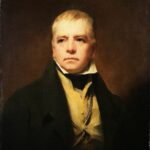James IV (1488–1513): The Renaissance King and the Tragedy of Flodden
The reign of James IV (Seumas IV Stiùbhart), from 1488 to 1513, marked one of the most dynamic and transformative periods in Scottish history. James IV inherited a throne tarnished by the violent and divisive reign of his father, James III, who had been overthrown and killed at the Battle of Sauchieburn in 1488. Ascending the throne as a teenager, James IV faced the immediate challenge of restoring royal authority in a kingdom fractured by aristocratic rivalries and weakened by internal unrest. Yet through a combination of political skill, military strength, and cultural ambition, James IV emerged as one of the most successful and charismatic monarchs of the House of Stewart.
James IV’s reign was defined by Scotland’s growing prominence on the European stage, the flourishing of the Scottish Renaissance, and significant domestic reforms that strengthened the crown’s authority. He modernized Scotland’s military, promoted naval expansion, and fostered intellectual and artistic growth. However, his strategic miscalculation in aligning with France against England—part of the broader conflict of the War of the League of Cambrai—culminated in the catastrophic defeat at the Battle of Flodden in 1513. James IV’s death on the battlefield ended one of the most promising reigns in Scottish history and plunged the kingdom into a prolonged period of political instability.
As historian Michael Lynch observes, “James IV embodied the promise of a Renaissance prince—a king whose cultural sophistication and military ambition elevated Scotland’s status in Europe, but whose tragic death at Flodden left the kingdom exposed and politically vulnerable” (Lynch, 1991).
The Rise of James IV and the Political Context of His Reign
James IV was born on 17 March 1473 at Stirling Castle, the eldest son of James III and Margaret of Denmark. His early life was shaped by the political instability of his father’s reign. James III’s reliance on low-born advisors and his alienation of the Scottish nobility created widespread resentment among the aristocracy. In 1488, a faction of nobles, led by Archibald Douglas, 5th Earl of Angus, persuaded the 15-year-old James to rebel against his father. The resulting conflict culminated in the Battle of Sauchieburn on 11 June 1488, where James III was killed—possibly by his own fleeing troops.
James IV’s accession was, therefore, shadowed by guilt and political fragility. Legend holds that James IV wore an iron chain around his waist for the remainder of his life as penance for his role in his father’s death. Nevertheless, his youth and charisma helped him consolidate power rapidly.
The nobles who had supported James’s rebellion expected political rewards, but James proved adept at managing these factions. He combined patronage with strategic marriages and military appointments, ensuring that the crown retained influence over the nobility while preventing any single faction from dominating. By 1490, James IV had established himself as a politically mature and independent ruler, in contrast to the weak and often ineffectual leadership of his father.
Michael Brown writes that “James IV’s rise reflected a masterful balance of political pragmatism and personal charisma—a young king who understood the necessity of both strength and diplomacy in securing the throne” (Brown, 2004).
Political and Military Challenges
1. Suppression of Noble Rebellions
James IV’s early years were marked by noble rebellions and political instability. The most serious challenge came from the Lords of the Isles in the western Highlands. The MacDonalds had maintained a semi-independent power base in the Hebrides and western Scotland, resisting direct control by the crown.
In 1493, James IV acted decisively by revoking the title of Lord of the Isles and incorporating the western territories into the crown’s holdings. His military campaigns in the Highlands and Islands, supported by a newly established royal navy, secured royal authority in the region and dismantled the MacDonalds’ power.
Michael Lynch notes that “James IV’s successful suppression of the Lords of the Isles marked the final consolidation of royal authority over the Highlands—a victory that eluded previous Stewart monarchs” (Lynch, 1991).
2. Naval Expansion and the Rise of Scottish Maritime Power
James IV was a visionary in naval affairs, recognizing the importance of maritime strength in asserting Scotland’s influence in northern Europe. He commissioned the construction of the Great Michael in 1511—the largest warship in Europe at the time, measuring over 240 feet and armed with 24 heavy guns.
James established the Royal Scots Navy as a permanent force, securing naval bases along the east and west coasts and strengthening trade and military links with France, Denmark, and the Netherlands. His strategic focus on naval strength was designed to protect Scotland’s maritime borders and enhance its diplomatic standing in European power politics.
Richard Oram argues that “James IV’s investment in naval power reflected his broader strategic ambition to position Scotland as a significant military and diplomatic force in northern Europe” (Oram, 2011).
3. Marriage to Margaret Tudor and the Treaty of Perpetual Peace
In 1503, James IV married Margaret Tudor, the daughter of Henry VII of England. The marriage was part of the Treaty of Perpetual Peace, which sought to end centuries of Anglo-Scottish conflict. The marriage represented a diplomatic coup for James IV, securing Scotland’s status as an independent and equal power on the British Isles.
The marriage also established the foundation for the eventual union of the Scottish and English crowns in 1603 under James VI, a direct descendant of James IV and Margaret Tudor.
4. The War of the League of Cambrai and the Battle of Flodden
Despite the Treaty of Perpetual Peace, Scotland remained diplomatically aligned with France through the Auld Alliance. In 1512, when Henry VIII invaded France as part of the broader conflict of the War of the League of Cambrai, James IV faced intense pressure to honor his treaty obligations to France.
In 1513, James led a Scottish invasion of northern England. The Scottish army—numbering nearly 30,000 men—crossed the border and laid siege to Norham Castle. However, on 9 September 1513, at the Battle of Flodden, the Scottish army was disastrously defeated by an English force led by Thomas Howard, Earl of Surrey.
James IV was killed in the fighting, along with much of Scotland’s nobility, including nine earls, 13 lords, and over 10,000 soldiers. James’s death on the battlefield was the last time a reigning British monarch died in combat.
Michael Brown writes that “Flodden was not merely a military defeat—it was a national catastrophe that shattered Scotland’s political and military elite and left the kingdom vulnerable to English aggression” (Brown, 2004).
Accomplishments and Legacy
James IV’s accomplishments were profound despite his tragic death. His suppression of the Lords of the Isles ended centuries of semi-independent rule in the Highlands and ensured greater political stability. His naval expansion secured Scotland’s maritime strength and enhanced its diplomatic position in Europe. His patronage of the arts, including the flourishing of the Scottish Renaissance at Linlithgow Palace and Edinburgh, left a cultural legacy unmatched by any previous Scottish monarch.
James IV’s marriage to Margaret Tudor planted the seed for the eventual union of the crowns, creating the dynastic link that would lead to the ascension of James VI to the English throne in 1603.
Yet Flodden overshadowed these achievements. The loss of so many nobles and the death of James IV created a power vacuum that plunged Scotland into a period of regency and factional conflict.
Conclusion
James IV was a monarch of immense ability and tragic miscalculation. His political, military, and cultural successes transformed Scotland into a more unified and influential kingdom. Yet his fatal misstep at Flodden, driven by the complex entanglement of Scottish and French diplomacy, ended one of the most promising reigns in Scottish history. As Michael Lynch concludes, “James IV was Scotland’s most brilliant king—a ruler whose tragic death at Flodden marked both the height of Stewart ambition and the beginning of Scotland’s long political decline” (Lynch, 1991).
References
- Lynch, Michael. (1991). Scotland: A New History. Pimlico.
- Brown, Michael. (2004). The Stewart Dynasty. Edinburgh University Press.
- Oram, Richard. (2011). The Kings and Queens of Scotland. Tempus Publishing.






